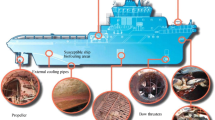Abstract
This study analyzes the algorithm by which the animal's nervous system evaluates spatially distributed temporal patterns of electroreceptive information. The outcome of this evaluation controls the jamming avoidance response, which is a shift in the animal's electric organ discharge frequency away from similar foreign frequencies. The encoding of “behaviorally relevant” stimulus variables by electroreceptors and the central computation of their messages are investigated by combined behavioral and neurophysiological strategies.
Similar content being viewed by others
References
Szabo, T., Fessard, A., in: Handbook for Sensory Physiology, Vol. III/3, p. 59 (Fessard, A., ed.). Berlin-Heidelberg-New York: Springer 1974
Maler, L.: J. Comp. Neurol.183, 2, 323 (1979)
Maler, L., Finger, T., Karten, H.J.: ibid.158, 363 (1974)
Heiligenberg, W., et al.: Missing links in the neuronal hardware of the jamming avoidance response (JAR) in the electric fish,Eigenmannia. Society of Neuroscience, 10th annual meeting. Vol. 6, abstract 00230 (1980)
Lissmann, H.W., Machin, K.E.: J. Exp. Biol.35, 451 (1958)
Heiligenberg, W.: Principles of Electrolocation and Jamming Avoidance in Electric Fish (Studies of Brain Function, Vol. 1, p. 1). Berlin-Heidelberg-New York: Springer 1977
Bullock, T.H., Behrend, K., Heiligenberg, W.: J. Comp. Physiol.103, 97 (1975)
Watanabe, A., Takeda, K.: J. Exp. Biol.40, 57 (1963)
Heiligenberg, W.: J. Comp. Physiol.87, 137 (1973)
Heiligenberg, W., Baker, C., Matsubara, J.: ibid.127, 267 (1978)
Heiligenberg, W., Bastian, J.: ibid.136, 113 (1980)
Bastian, J., Heiligenberg, W.: ibid.136, 135 (1980)
Bastian, J., Heiligenberg, W.: Science (in press)
Partridge, B.L., Heiligenberg, W.: J. Comp. Physiol.136, 153 (1980)
Bullock, T.H., Hamstra, R.H., Scheich, H.: ibid.77, 1 (1972)
Scheich, H., Bullock, T.H., in: Handbook of Sensory Physiology, Vol. III/3, p. 201 (Fessard, A., ed.). Berlin-Heidelberg-New York: Springer 1974
Scheich, H.: J. Comp. Physiol.113, 181 (1977)
Heiligenberg, W., Partridge, B.L.: in preparation
Scheich, H., Bullock, T.H., Hamstra, R.H.: J. Neurophysiol.36, 39 (1973)
Reichardt, W., in: Sensory Communication, p. 303 (Rosenblith, W.A., ed.). New York: Wiley 1961
Author information
Authors and Affiliations
Additional information
I thank Drs. H. Autrum, T.H. Bullock and C.L. Baker for most helpful comments on this manuscript. This research was supported by NIMH grant PHSMH-2614904 and NSF grant BNS76-20761.
Rights and permissions
About this article
Cite this article
Heiligenberg, W. The jamming avoidance response in the weakly electric fishEigenmannia . Naturwissenschaften 67, 499–507 (1980). https://doi.org/10.1007/BF01047630
Received:
Issue Date:
DOI: https://doi.org/10.1007/BF01047630




